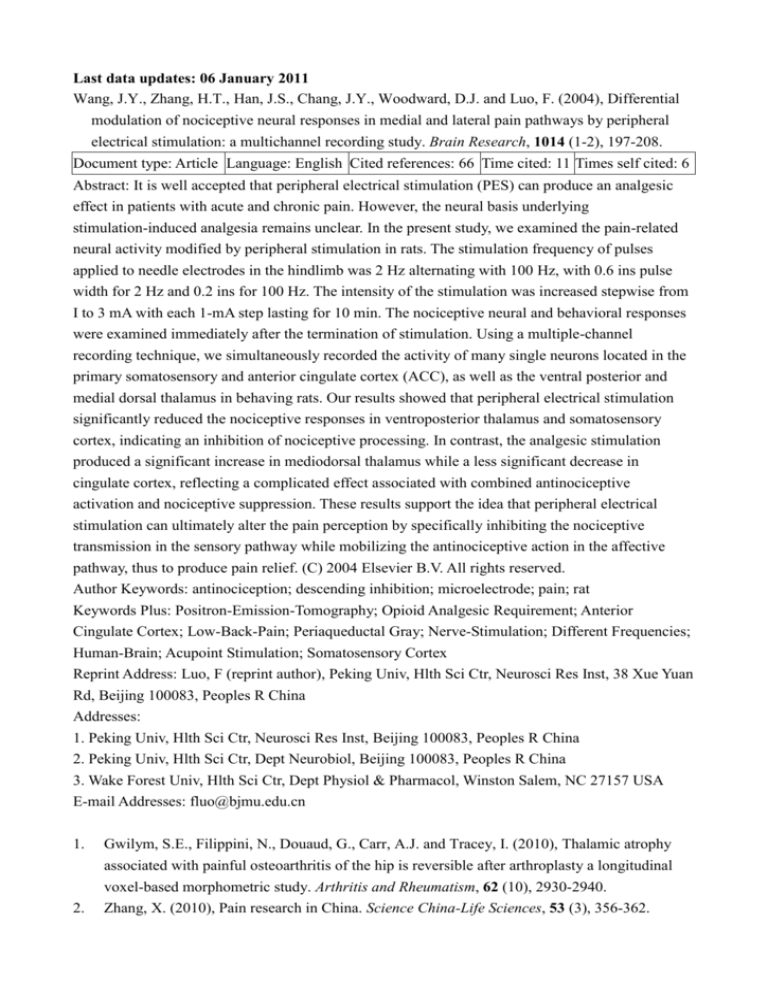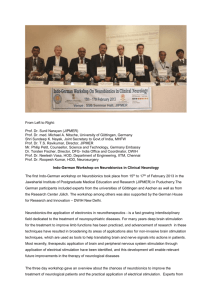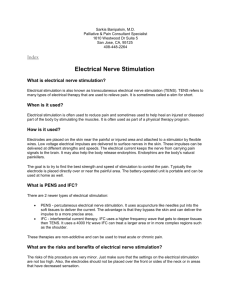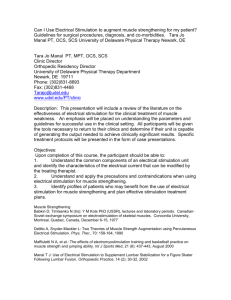
Last data updates: 06 January 2011
Wang, J.Y., Zhang, H.T., Han, J.S., Chang, J.Y., Woodward, D.J. and Luo, F. (2004), Differential
modulation of nociceptive neural responses in medial and lateral pain pathways by peripheral
electrical stimulation: a multichannel recording study. Brain Research, 1014 (1-2), 197-208.
Document type: Article Language: English Cited references: 66 Time cited: 11 Times self cited: 6
Abstract: It is well accepted that peripheral electrical stimulation (PES) can produce an analgesic
effect in patients with acute and chronic pain. However, the neural basis underlying
stimulation-induced analgesia remains unclear. In the present study, we examined the pain-related
neural activity modified by peripheral stimulation in rats. The stimulation frequency of pulses
applied to needle electrodes in the hindlimb was 2 Hz alternating with 100 Hz, with 0.6 ins pulse
width for 2 Hz and 0.2 ins for 100 Hz. The intensity of the stimulation was increased stepwise from
I to 3 mA with each 1-mA step lasting for 10 min. The nociceptive neural and behavioral responses
were examined immediately after the termination of stimulation. Using a multiple-channel
recording technique, we simultaneously recorded the activity of many single neurons located in the
primary somatosensory and anterior cingulate cortex (ACC), as well as the ventral posterior and
medial dorsal thalamus in behaving rats. Our results showed that peripheral electrical stimulation
significantly reduced the nociceptive responses in ventroposterior thalamus and somatosensory
cortex, indicating an inhibition of nociceptive processing. In contrast, the analgesic stimulation
produced a significant increase in mediodorsal thalamus while a less significant decrease in
cingulate cortex, reflecting a complicated effect associated with combined antinociceptive
activation and nociceptive suppression. These results support the idea that peripheral electrical
stimulation can ultimately alter the pain perception by specifically inhibiting the nociceptive
transmission in the sensory pathway while mobilizing the antinociceptive action in the affective
pathway, thus to produce pain relief. (C) 2004 Elsevier B.V. All rights reserved.
Author Keywords: antinociception; descending inhibition; microelectrode; pain; rat
Keywords Plus: Positron-Emission-Tomography; Opioid Analgesic Requirement; Anterior
Cingulate Cortex; Low-Back-Pain; Periaqueductal Gray; Nerve-Stimulation; Different Frequencies;
Human-Brain; Acupoint Stimulation; Somatosensory Cortex
Reprint Address: Luo, F (reprint author), Peking Univ, Hlth Sci Ctr, Neurosci Res Inst, 38 Xue Yuan
Rd, Beijing 100083, Peoples R China
Addresses:
1. Peking Univ, Hlth Sci Ctr, Neurosci Res Inst, Beijing 100083, Peoples R China
2. Peking Univ, Hlth Sci Ctr, Dept Neurobiol, Beijing 100083, Peoples R China
3. Wake Forest Univ, Hlth Sci Ctr, Dept Physiol & Pharmacol, Winston Salem, NC 27157 USA
E-mail Addresses: fluo@bjmu.edu.cn
1.
2.
Gwilym, S.E., Filippini, N., Douaud, G., Carr, A.J. and Tracey, I. (2010), Thalamic atrophy
associated with painful osteoarthritis of the hip is reversible after arthroplasty a longitudinal
voxel-based morphometric study. Arthritis and Rheumatism, 62 (10), 2930-2940.
Zhang, X. (2010), Pain research in China. Science China-Life Sciences, 53 (3), 356-362.
3.
Wang, J.Y., Huang, J., Chang, J.Y., Woodward, D.J. and Luo, F. (2009), Morphine modulation
4.
of pain processing in medial and lateral pain pathways. Molecular Pain, 5, Article Number: 60.
Luo, F. and Wang, J.Y. (2008), Modulation of central nociceptive coding by acupoint
5.
6.
stimulation. Neurochemical Research, 33 (10), 1950-1955.
Qiao, Z.M., Wang, J.Y., Han, J.S. and Luo, F. (2008), Dynamic processing of nociception in
cortical network in conscious rats: A laser-evoked field potential study. Cellular and
Molecular Neurobiology, 28 (5), 671-687.
Yu, A.C.H., Wan, Y., Chui, D.H., Cui, C.L., Luo, F., Wang, K.W., Wang, X.M., Wang, Y.,
Wu, L.Z., Xing, G.G. and Han, J.S. (2008), The Neuroscience Research Institute at Peking
University: A place for the solution of pain and drug abuse. Cellular and Molecular
7.
Neurobiology, 28 (1), 13-19.
Kishima, H., Saitoh, Y., Osaki, Y., Nishimura, H., Kato, A., Hatazawa, J. and Yoshimine, T.
(2007), Motor cortex stimulation in patients with deafferentation pain: activation of the
8.
posterior insula and thalamus. Journal of Neurosurgery, 107 (1), 43-48.
Saade, N.E., Al Amin, H., Baki, S.A., Chalouhi, S., Jabbur, S.J. and Atweh, S.F. (2007),
Reversible attenuation of neuropathic-like manifestations in rats by lesions or local blocks of
9.
the intralaminar or the medial thalamic nuclei. Experimental Neurology, 204 (1), 205-219.
Wang, J.Y., Chang, J.Y., Woodward, D.J., Baccala, L.A., Han, J.S. and Luo, F. (2007),
Corticofugal influences on thalamic neurons during nociceptive transmission in awake rats.
Synapse, 61 (5), 335-342.
10. Murrell, J.C. and Johnson, C.B. (2006), Neurophysiological techniques to assess pain in
animals. Journal of Veterinary Pharmacology and Therapeutics, 29 (5), 325-335.
11. Yang, H., Chang, J.Y., Woodward, D.J., Baccala, L.A., Han, J.S. and Luo, F. (2005), Coding
of peripheral electrical stimulation frequency in thalamocortical pathways. Experimental
Neurology, 196 (1), 138-152.









